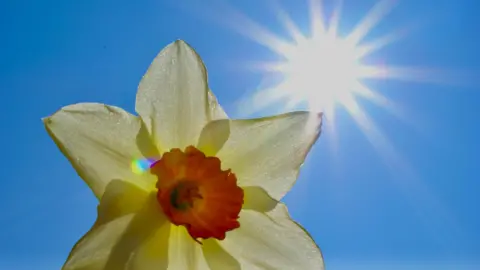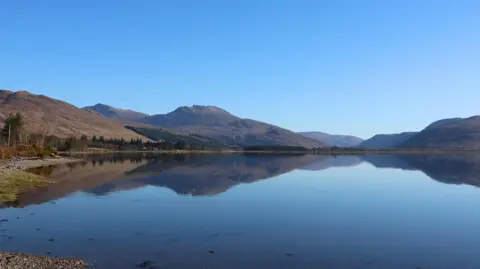How long is this good weather going to last?
 BBC Weather Watchers / Nellington
BBC Weather Watchers / NellingtonThe clocks changed and like the flick of a switch, spring roared into life this week.
The start of April has so far been characterised by dry, sunny days in Scotland - with some parts of the country nearing 20C. But how long can it last?
To understand the current weather, we need to look to the jet stream and pressure patterns overhead.
These large-scale drivers in our atmosphere help influence the type of weather we experience - and sometimes they get stuck, leading to static weather patterns that can last for days.
 NASA Worldview
NASA WorldviewAt the moment, a portion of the jet stream is running to our north.
These fast-flowing winds way up in the sky help direct weather systems our way.
This position allows high pressure known as an anti-cyclone, to become established and maintained overhead.
It acts like a rock in a stream, effectively blocking any incoming weather systems and rain.
Known as a "blocking high", it can last for 10 days or more and coupled with increasingly strong April sunshine, it allows the temperature to climb.
 BBC Weather Watchers / Ingrid
BBC Weather Watchers / IngridAchnagart in the Highlands reached 20.4C on Thursday afternoon, making it the warmest temperature of the year so far in Scotland.
But while many areas basked in Spring warmth it wasn't the case everywhere.
High pressure keeps us dry, but we also need to look at which way the wind is blowing. Around high pressure, winds circulate in a clockwise motion but the source region for the air will dictate how warm it gets.
With high pressure centred to our east, we'll generally have a south to south-easterly wind, scooping up mild or warm air from the near continent.
However, if that high is to our north or north west the air is colder, arriving from Arctic-influenced north or north east.
 BBC Weather Watchers / Tartan Trunks
BBC Weather Watchers / Tartan TrunksSea-surface temperatures also have a big impact. At this time of year the sea around the UK is generally at its coldest point after cooling down all winter.
Thermal inertia means there's a lag in the sea heating up despite the warming weather. So, if there's an on-shore breeze where you are, it will feel chilly compared with areas further inland where the air has a chance to warm up before reaching you.
The sun is increasingly strong in April too, in fact it's similar to late August or early September, so sunburn is possible as UV levels become moderate - even if you're in a chilly sea-breeze.
More dry conditions follow a dry March
The current forecast is for the high pressure to remain dominant well into next week, with no appreciable rain expected until at least Friday.
That's not good news for our farmers, growers and gardeners.
After a dry March which only delivered 64% of the normal rainfall for the month, dry conditions could start to become a problem.
Firefighters have already warned of an "extreme risk" of wildfires in the coming days.
By the middle of the month, weather models are less certain on what happens next.
We could start to see low pressure, weather fronts and rain return from the Atlantic, though high pressure across north west Europe may win out, extending our dry spell even further.
